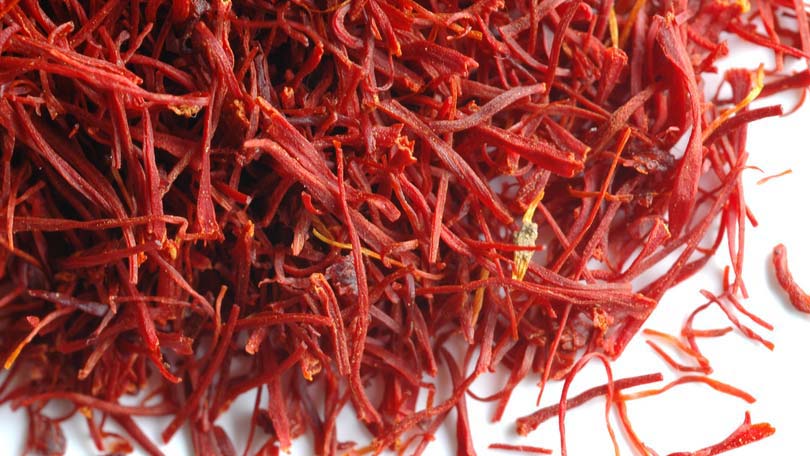
Saffron, the highly esteemed spice associated with Spanish, Mediterranean, and Middle Eastern cuisine, is the most expensive spice in the world. Derived from the beautiful saffron crocus native to Southwest Asia, saffron has been cultivated for well over 3000 years and is almost literally worth its weight in gold.
Characteristics
The saffron crocus (a member of the iris family), or Crocus sativus linneaus, is a small beautiful flower native to dry, hot climates such as Asia and India. It grows roughly 3-5 inches in height and has a firm, pale green stem. The flower has distinctive vibrant purple petals and three crimson-orange stigmas which protrude from the flower’s center. The stigmas are dried and used whole or ground as dyes, medicine, or for spicing. Saffron has a specific bitterness with flavors of honey and hay, and a hay-like aroma. The stigmas must be dried in order to mellow their intense flavor; when fresh saffron’s bitterness is overpowering.
The plant itself is not easy to grow and is popular amongst garden pests like rabbits and insects, making growing even more difficult – it’s best to leave this one to the professionals.
Common Uses
Saffron has experienced more success than almost any other herb or spice in history; it is mentioned in Greek mythology and the Bible, and was prized by the Egyptian royalty. According to records, saffron first began being used in Ancient Greece and the Mediterranean. It then moved on to Spain and its outlying regions, with Britain and other parts of Europe joining in by the 14th century. In England it eventually became the symbol of the British House of Essex and appears on their coat of arms. At times it was so valued it was used and traded as currency, and it remains the most expensive herb in the world by weight. This is largely because of the labor involved in cultivating it – the stigmas must be removed one at a time by hand, and it takes around 70,000 stigmas to create just one pound of the spice.
Saffron is commonly associated with Arab, European, Moroccan, and Spanish cuisine. The spice is used to flavor rice dishes, risottos, pilafs, seafood, bouillabaisse, soups, teas, wine, buns, pound cake, and the Indian dessert kheer.
Saffron’s characteristic hue is due to a unique chemical makeup which is high in the pigment carotenoid. The pigment is water-soluble, allowing it to transfer into most liquids for dyes. The threads give off a bright yellow-gold color which has been revered by royalty and monks in some cultures, and was a status symbol for a time. Saffron’s pigment was also added to make-up and cosmetics, and its aroma has been added to perfumes.
As a medicine saffron was believed to be a treatment for many ailments including depression, melancholy, immune dysfunction, wounds, and even the black plague.
Use and Storage
Saffron’s thread-like stigmas should always be a uniform red-orange color; uneven color is a sign of inferiority. The dried spice is available in most large or specialty markets; it can also be purchased directly from distributors via the internet. Its flavor is best preserved by storing in an airtight container in the freezer.
The powdered variety is less desirable than the threads as it is less potent and has a shorter shelf life. Powdered saffron is also frequently cut with less expensive fillers like turmeric or safflower and is therefore less pure than its dried equivalent.
Saffron is very potent – use a little at a time and add more if needed.
Use It (How to/where)
- in Spanish paella
- in rice dishes, risotto, and pilaf
- in bouillabaisse and delicate fish dish soups
- to scent seafood
- to flavor lamb and deep flavored red meats
- to flavor tea and wine
- infused in butter for sauces
- in baked goods like saffron cake or breads
Recipes using Saffron
Saffron Scented Tea
¼ teasp. Saffron threads
¼ – ½ tsp. ground cardamom
2 tbs. fresh lemon juice
2-3 tbs. honey
4 Darjeeling or black tea bags, or four teaspoons loose leaf black tea
4 cups water
Boil water and brew tea in pot, letting steep for 4-5 minutes. Remove tea bags. Add lemon juice, honey, and cardamom and stir until dissolved. Add saffron and let stand another five minutes. Strain tea into glasses and enjoy.
